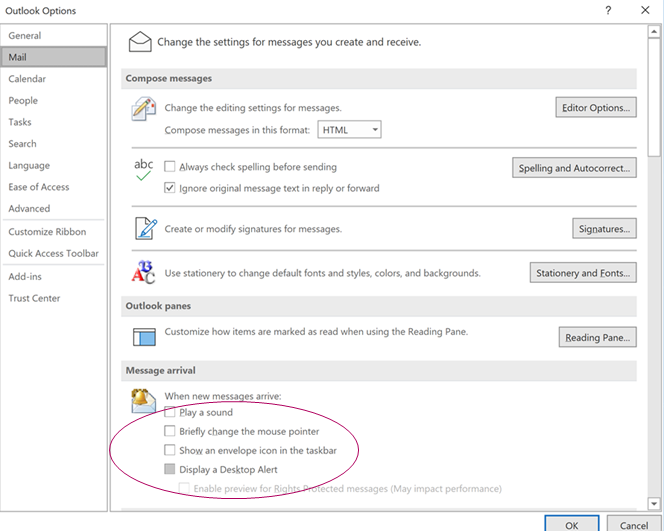Email is a necessary part of modern life and work, but while it’s now an important method of communication, it’s not always great for productivity. It may seem that email is a great way to help you get more done, but the truth is, those email notifications can be highly distracting. Every time you stop what you’re doing to read and respond to a new email, you’re really just interrupting your workflow—and it can take an average of 20 minutes to fully get it back again. Instead of letting every new email distract you from your current task, why not turn off your notifications? It’s easy to do, and once you’ve gotten rid of those pesky popups, you may find your productivity is noticeably improved.
Turn Off Notifications in Outlook
In the Outlook desktop app, you’ll get a popup notification when you receive a new email, meeting request, or task request. These desktop alerts are turned on by default, so if you don’t want to receive them, you’ll need to turn them off. This is a quick and simple process.
1) Choose File > Options > Mail.
2) Under Message arrival, clear the check box for Display a Desktop Alert.
3) Click OK.
If you later decide to enable Desktop Alerts just perform the same steps and put a check in the Display a Desktop Alert box.

Turn Off Outlook Notifications in Windows
Depending on how your workstation is set up, you may also need to turn off Outlook notifications in your Windows settings. This is another easy process that takes only a minute or two.
1) Right click on the Windows taskbar. Make sure to click on a blank area rather than on an icon.
2) Choose Taskbar Settings.
3) Scroll down to the Notification area and click Select which icons appear on the taskbar.
4) Find the Microsoft Outlook entry. If there’s more than one entry for Outlook, find the one with the subheading You have new unread email messages.
5) Make sure the slider is set to the Off position to disable taskbar notifications.
6) Follow the same steps to re-enable notifications, and set the slider to the On position.

Turn Off Notifications for a Single Outlook Account
What if you want to disable email notifications for a single specific account, while leaving notifications active on other accounts?
To do this, you’ll need to disable notifications for all accounts, then create a new email alert rule to apply only to the accounts that you want alerts to be active on. This is a slightly longer process than those above.
1) Follow the above process to turn off notifications in Outlook.
2) In the Home tab, choose Rules > Manage Rules & Alerts.
3) Locate the Rules and Alerts dialogue box. Under the Email Rules tab, click New Rule. This will start the Rules Wizard.
4) On the first screen, find the Start from a blank rule section and click Apply rule on messages I receive. Then click Next.
5) On the next screen, click Next then choose Yes on the dialogue window that pops up.
6) On the next screen, check the box that reads display a Desktop Alert then click Next.
7) On the next screen, for Step 1 check the box that reads except through the specified account.
For Step 2 click the word specific. On the popup dialogue box that appears, choose the email account for which you want to disable notifications. Click the OK button and then click Next.
8) On the last screen, choose a name for the rule you just created. Make sure the box labelled Turn on this rule is checked then click Finish.
9) Finally, click OK in the Rules and Alerts window.
Once this process is complete, all accounts, except the one you specified, will receive email notifications.
A Better Way to Deal with Email
If you turn off notifications, you won’t see a note for every new email as it arrives. For some people, the idea of not receiving notifications may be a bit anxiety-inducing—after all, what if it’s really important? Luckily, it’s easy to set up your day to deal with email more effectively.
One option is to designate one or more time points over the course of the day, during which you’ll read and respond to new email. For instance, these could be first thing in the morning, after lunch, and at the end of the day. Once you’ve picked out some time blocks, put on your calendar and get into the habit of only checking email at these times.
Alternatively, if you really feel you need to check your email more often, resolve to do it every two hours, or every hour. Just 8% to 11% of people expect a reply to an email in under an hour, but around 40% prefer a reply within one hour—so, if you check email hourly, you’re meeting or exceeding the majority of expectations.
For more tips and tricks to get more out of Outlook, get in touch with ACUTEC today.

